ARCHAEOLOGICAL SITES IN AGUASCALIENTES
Mexico » States » Aguascalientes » Archaeological Sites
Archaeological Zones in AGUASCALIENTES
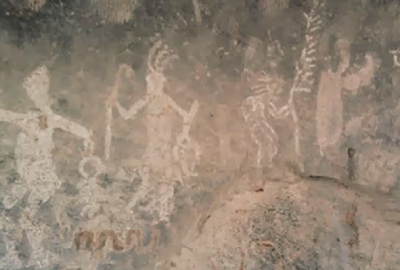
The state of Aguascalientes is probably one of the least studied entities in terms of archaeology. Until a few decades ago, the history of the state began with the founding of the city of Aguascalientes, and little or nothing was mentioned about the indigenous populations that were not in opposition to the Spanish colonizing efforts, whether they were the so-called Chichimecas or some ethnic group related to them.
From the nineties of the last century, however, formal investigations would begin, and until the year 2000 an archaeological site was finally investigated constantly by INAH personnel. Based on these new investigations, the entity’s indigenous past began to be explored, and in the present a richer panorama is being discovered than would have been thought.
In contrast, the surrounding regions of Aguascalientes have a longer history of research, and therefore, to understand the pre-Hispanic past of what is now Aguascalientes, its territory must be integrated into a region that far exceeds the current limits of the entity. This extended region is commonly identified in specialized literature as “the northern border of Mesoamerica”.
Dueñas García, Manuel de Jesús, “La arqueología de Aguascalientes”, Arqueología Mexicana, núm. 167, pp. 28-35.
Before the colony, the history of Aguascalientes was reduced to a place of passage for nomadic and semi-nomadic Chichimeca peoples. Now, thanks to research by the National Institute of Anthropology and History (INAH), it has been shown that ancient settlers with their own organization and worldview settled in these territories.
These are four archaeological zones, El Ocote, La Montesita, Cerro de Enmedio and Cerro de Santiago, which have also been delimited for their cultural value as geosites by the UNESCO Geopark Project “Water Routes” where it is sought that in each of the areas that compose it stand out, not only for their geological value, but also for their biodiversity, natural and cultural wealth, the inclusion of surrounding communities and collective enjoyment.
El Ocote
Located southeast of the current state of Aguascalientes, on the border with Jalisco, the site of El Ocote is in an environmental transition zone, as it has access to resources from a forest area (which in the past was surely larger) and of low deciduous forest. The human settlement is distributed on and around Los Tecuanes hill, whose approximate area is 17 ha; in its vicinity it has some springs, as well as a stream that currently has intermittent flow.
Los Tecuanes hill is an extrusive volcanic rock formation identified as ignimbrite, with the presence of consolidated tuff and rhyolite, a rocky substrate that was used for different purposes. A construction zone is observed on the top of the hill whose function probably corresponded to activities associated with the worldview of its inhabitants.
Pelz Marín, Ana María, “El Ocote, Aguascalientes”, Arqueología Mexicana, núm. 167, pp. 48-53.
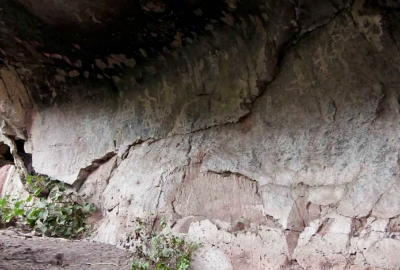
At the top of the Cerro de los Tecuanes you can find several pyramidal bases. The site has an extension of 60 ha. The development of the settlement took place mainly between 650 and 900 AD, in the so-called Epiclassic period; hence, it is still not possible to define the groups that lived here, although it is clear that they predate the Chichimeca tribes.
In this archaeological zone, you can see several remains and cave paintings where anthropomorphic and zoomorphic representations are observed. Here 80,000 ceramic fragments have been found, of which 200 bone tools, 200 ornamental pieces, as well as 32 bodies and skeletons have been identified in burial sites. As if this were not enough, in El Ocote sanctuaries have been found on the top of the hill, altars and cave paintings.
At the foot of Cerro de los Tecuanes, grinding objects, bone remains of animals, stoves, tools made of flint, obsidian and rhyolite were found; in addition to clay objects and bone instruments; also seeds. In this place there were also indications of a post, column bases and objects related to the construction.
La Montesita
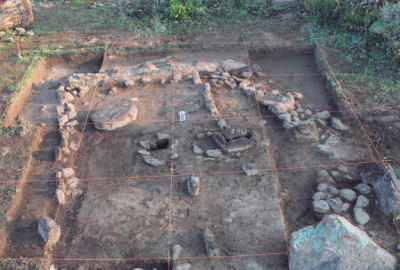
In 2011, in response to a report of findings of archaeological materials, representatives of the INAH Aguascalientes Center went to the scene of the events and identified an archaeological site with intense looting. Around some looting pits, fragments of ceramics, bones and lithic objects were found on the surface. In addition, remains of structures were found, some of which clearly exceeded the size of simple dwellings. Most of the site is in the ejido of Las Negritas, in the municipality of Puesta, in the extreme east of the state of Aguascalientes, and another part is in the ejido of Los Campos, Zacatecas.
To follow up on these discoveries, the La Montesita Archaeological Project (Proyecto Arqueológico La Montesita (PALM)) was started, which is developed by professors and students of the Archeology degree at the Autonomous University of San Luis Potosí, in close collaboration with the INAH Aguascalientes Center. Within the framework of the project, so far, six field seasons have been carried out.
A review of the archaeological literature on the region showed that some references already existed to a site at this location, identified as one of the largest in the region, and named primarily in connection with its cave paintings. The hill of La Montesita itself, which gives the site its name, is a rocky outcrop with a maximum height of 2,246 meters above sea level. The region in which it is found is characterized by a temperate semi-dry climate with thorny desert forest vegetation. Today the site is a place of passage for shepherds who go to the rainfed water sources.
Schulze, Niklas y Gilberto Pérez Roldán, “La Montesita, Aguascalientes”, Arqueología Mexicana, núm. 167, pp. 42-47.
Cerro de en Medio
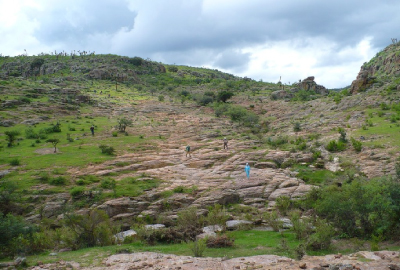
El Cerro de en Medio archaeological site is exceptional in more ways than one. Its name derives from its peculiar location, a table in the middle of a canyon; but unlike the other sites of the Verde Grande River, and in particular Aguascalientes, the ceremonial center and the residential area are located on the top of the hill.
In addition to this, its difficult access between canyons makes us wonder about the defensive character it could have had. The site began to be studied in the 1990s, and the first explorations interpreted it as a camp for semi-nomadic societies, a judgment based mainly on a partial exploration of the settlement and inspired by the chronicles of the Spanish invasion.
It was not until 2012 that due to the intensive work on the site, the maps were updated, the surface constructions were recorded in detail, and the analysis of materials recovered on the surface and in archaeological excavations began.
Dueñas García, Manuel de Jesús y Miriam Selene Campos Martínez. “El Cerro de en Medio, Aguascalientes. Asentamiento prehispánico escondido entre cañones”, Arqueología Mexicana, núm. 167, pp. 54-59.
Cerro de Santiago
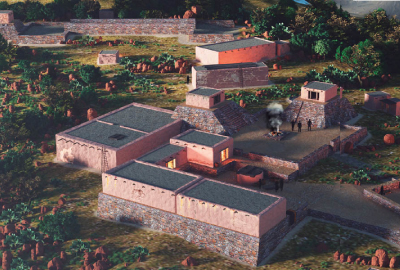
Aguascalientes is in many ways an unknown land in terms of knowledge and understanding of pre-Hispanic cultures. Recent studies at the Cerro de Santiago archaeological site show a population whose characteristics link it to its southern neighbors, since it has Mesoamerican features that indicate a macro-regional interaction during the Epiclassic. In the northern border of Mesoamerica, which includes the Lerma-Santiago region, very important events took place during the Late Classic and the Epiclassic.
In the Lerma-Santiago region is the Verde Grande river basin, which covers southern Zacatecas, most of the state of Aguascalientes, a small part of northwestern Guanajuato, and a large part of the Jalisco mountains. The cultural expansion that took place during the Late Classic did not have great natural barriers that limited the contacts between them, perhaps for this reason the notable similarities.
Recent research on the Cerro de Santiago archaeological site, north of the Verde Grande River, yields new data that reveals not only the pre-Hispanic occupation, but also shows the process of interaction that took place along the expansive northern border of Mesoamerica. Recent studies of northern Mesoamerica have focused mainly on trying to explain the appearance and subsequent abandonment of populations with Mesoamerican characteristics.
Caretta, M. Nicolás y Becket Lailson Tinoco, “Cerro de Santiago, Aguascalientes”, Arqueología Mexicana, núm. 167, pp. 36-41.
Cave Paintings El Tepozán
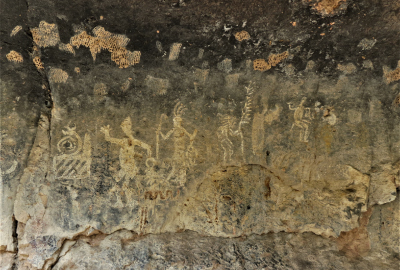
They are anthropomorphic figures of different colors with superimpositions that correspond to different times. To date, five overlays have been found and each of them is a different color such as black, orange, red, white and yellow. The black ones are the oldest. The best preserved paintings are blank and represent schematic anthropomorphic figures that represent bodies dressed in headdresses, weapons or canes.
There are also some large yellow paintings that represent Caravaca crosses, as well as other smaller crosses and graffiti of the same. color that seek to cover the previous glyphs.They are located in the municipality of Calvillo in a cave that is known as El Meco, under the shelter of a large rock. To get there you have to cross a dirt path until you reach some rocks and cross a river that is surrounded by coniferous trees.
You can practice various activities such as mountain biking, 4×4 jeep rides, motorcycles, rappelling, hiking. At the dam it is possible to do recreational fishing and enjoy boat rides. Its spring of blue water, which flows between the stones is called Ojo de Agua, it is a place of natural beauty that is accompanied by a varied wild vegetation, ideal for nature lovers. The impressive waterfall can be seen during the rainy season, which flows into a river that also offers incomparable landscapes.
El Vigilante
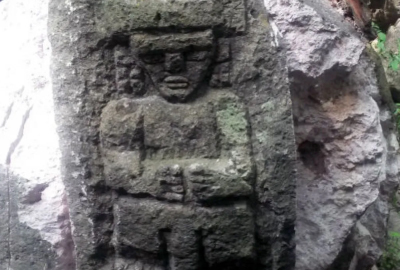
In 2014 a stone engraving called “El Vigilante” (The Vigilant) was discovered, considered as a unique piece in the State and the region. It was located at the base of the Huenchos waterfall, and the site is also something special.
The human figure was found with damage that highlights the interest of the perpetrators in detaching the piece from its site; and that time, the INAH estimated that the petroglyph dated from the year 200 to 700 of our era.
The discovery of the pre-Hispanic piece at the foot of the waterfall was a 10-ton monolith, masculine in appearance that wore a headdress and earmuffs as ornamental elements, due to its design characteristics it is associated with the classic Teotihuacan period; an invaluable and unique sculpture in the State and the region, according to specialists. It was believed that the piece could come from a population settled in the Huejucar valley (today Calvillo), prior to the Chichimeca settlements.
In 2021, a two-meter-high pre-Hispanic female sculpture was discovered, an ancient statue of a woman, linked to the Huasteca culture, but this time the piece was found in perfect condition.
Map of Archaeological Sites in AGUASCALIENTES
More Tourist Attractions in AGUASCALIENTES
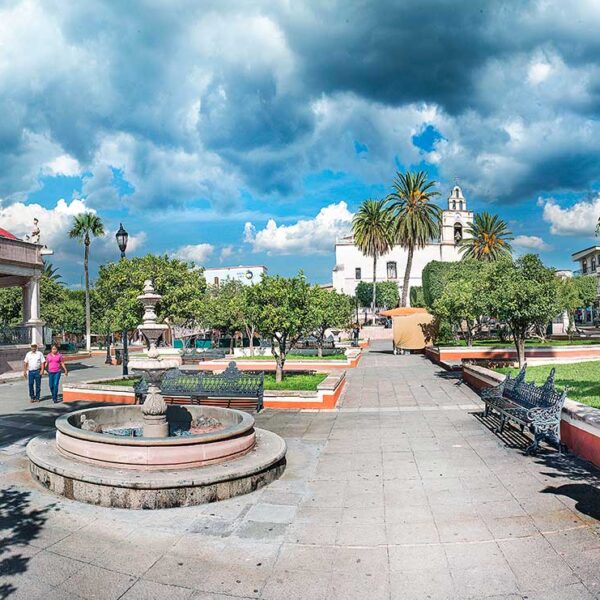
Magical Towns in Aguascalientes
Aguascalientes has three magical towns that are an excellent option to discover them at any time of the year, mainly on vacation. Calvillo, San José de Gracia and Real de Asientos are considered magic towns because they are places with symbolic attributes and transcendental events that marked their history, becoming alternatives for national and foreign tourists, and even for the people of Aguascalientes eager to know and live their history. In these three municipalities you can enjoy a vast gastronomy, festivals and traditions, as well as a great wealth of heritage, giving visitors the opportunity to live unique experiences.… Read More

Gastronomy of Aguascalientes
Aguascalientes is one of the smallest states in Mexico and which has a lot to offer to those who visit it. In fact, throughout history its geographical location has contributed to enrich its culture and gastronomy, thus becoming a unique multicultural mix. For this reason, in Aguascalientes you can find foods that are made throughout the country but with its own particular and unique touch. For example, this state has drinks that are inherited from pre-Hispanic times and delicious desserts made with native fruits.… Read More
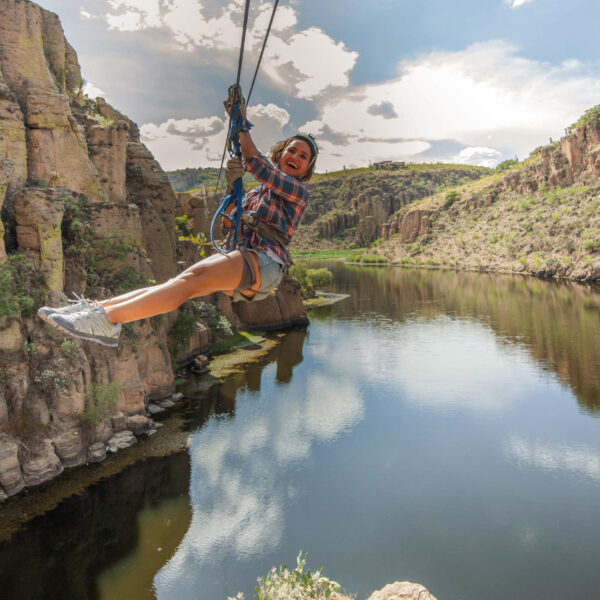
Ecotourism and Adventure in Aguascalientes
Ecotourism in Aguascalientes is lived in semi-desert landscapes, dams and trails surrounded by nature and cave paintings. Living ecotourism in Aguascalientes, you will love the beauty of its natural settings and the experiences that you can live here. The state is made up of vast semi-desert landscapes, with oases surrounded by water and fun ecotourism activities. In Aguascalientes there are several spaces close to the city where you can spend a weekend away from the hustle and bustle, in a much calmer and quieter environment, as well as of course getting a little active and exercising a little.… Read More

Aguascalientes City Surroundings
In Aguascalientes there is much to admire, from springs to charming towns and old haciendas. Further exploration of the state often includes visits to mineral springs. In the countryside surrounding the capital there are also beautiful old haciendas and colonial buildings, spas and the imposing Sierra Fría. If you like sports, you can practice rock climbing, rappelling, fishing, mountain biking and camping in the rural areas of the state.… Read More
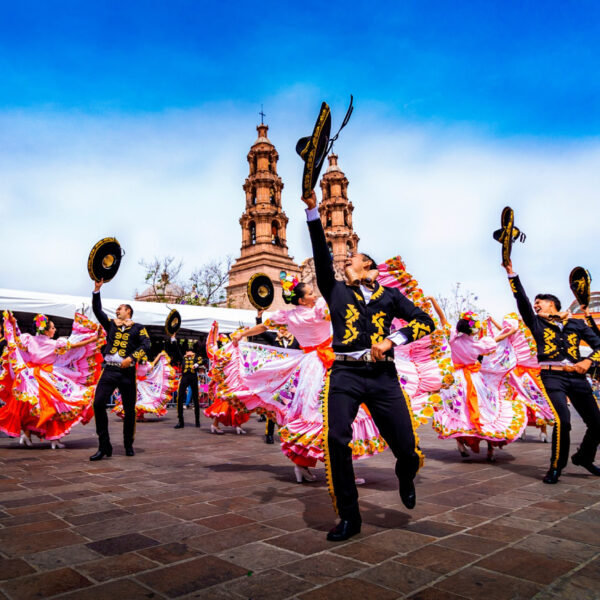
Traditions of Aguascalientes
Aguascalientes is a state of traditions and customs, a destination famous for its internationally recognized fairs and festivals; It is prepared to receive tourists and visitors throughout the year, some of its main tourist attractions are the San Marcos National Fair, the Skulls Cultural Festival, the Grape and Artisanal Cheese Fair.… Read More
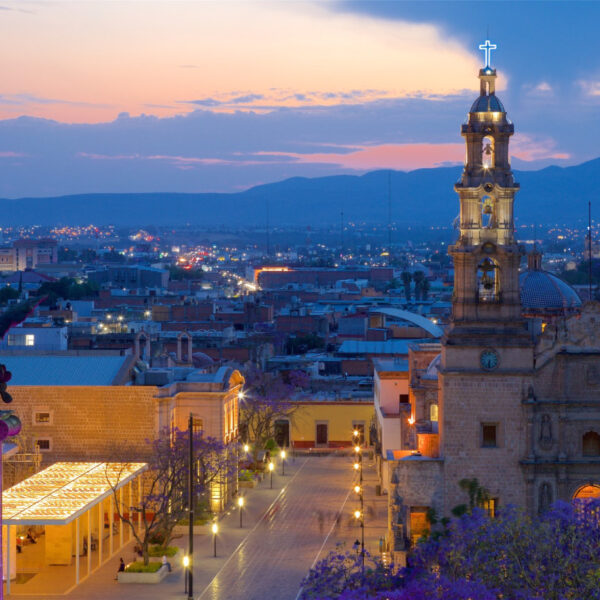
Aguascalientes City
The city of Aguascalientes, is despite its modernity a city with a pleasant colonial flavor. This city was founded in 1575, with the original name of Antigua Villa de Nuestra Asunción de las Aguas Calientes, due to the presence of hot springs in the area.… Read More
Flights & Hotels in AGUASCALIENTES
More Tourist Attractions in MEXICO

Traditions in Mexico
It is practically impossible to make a meticulous, and above all, accurate selection of the places to visit in Mexico. Each place that our country houses is unique and beautiful in its own way. Mexico, with its nearly 2 million km², has a large number of scenarios to offer, as well as endless activities to do. Do not lose your way and enter the places to visit in Mexico. In Mexico, apart from the beaches and its famous archaeological sites, there are many other really interesting sites and activities that you should know. In the surroundings of the main cities you will find places full of culture and tradition, where you can spend relaxing, interesting and fun vacations. On your trip through Mexico you cannot stop obtaining souvenirs, the crafts that are made here are of the highest quality and recognized worldwide. A shopping tour cannot be missed.… Read More

States Of Mexico
Mexico has an incredible diversity of landscapes, where the beauty of its beaches, internationally recognized, stands out. In its vast territory of coasts, there are beaches of unparalleled beauty, and colorful landscapes. A large network of first-class hotels and tourist services is available to visitors to these beaches. Mexico is also mystical places, dotted with archaeological testimonies inherited from its original inhabitants. Monuments made by the Mayas, Aztecs and Toltecs are located in magical landscapes, like lighthouses in an ocean of natural beauty. They offer visitors buildings that tell their history, and museums that collect their cultural heritage. And that keep alive ancestral traditions, in ceremonies and festivals, where you can enjoy cultural activities and entertainment.… Read More

Gastronomy
The Gastronomy of Mexico has a great diversity of typical dishes, which is why it was recognized by UNESCO as Intangible Heritage of Humanity. The basic and representative ingredients of Mexican dishes are: corn, coriander, chili, beans, piloncillo, nopal and tomato. Mexican cuisine is also characterized by its sauces, which serve as an accompaniment to traditional dishes, prepared based on spices.… Read More

Archaeological Sites
The Archaeological Zones are the cultural past of every Mexican. You will be amazed at the ambient, nature and the environment that surrounds them. Climbing to the top or being around it will take us back in time to admire every detail. México is a country of culture and traditions, many of which we have inherited from the pre-Hispanic inhabitants of this vast territory, although it is true that there were more settlements in the central and southern part of the country, it is also possible to find some archaeological remains in the north.
… Read More

Capital Cities
Folklore, gastronomy, literary culture, art and exhibitions, is what you will find in the capitals of the states of Mexico. To the north, colonial Mexico, Puebla, Guadalajara, Guanajuato, the Sonoran desert and the California peninsula. To the east Veracruz and the gulf. To the west Acapulco, Oaxaca and Tuxtla Gutiérrez. And to the south the Riviera Maya and the pyramids of Chichén-Itzá, Tulúm and Cobá in Yucatán, Palenque in Chiapas, the cenotes, and the Central American jungles.… Read More

Ecotourism and Adventure
Mexico is one of the best countries for Ecotourism as it has a great variety of flora and fauna, as well as a large number of refuges for extraordinary species. You can enjoy recreational activities of appreciation and knowledge of nature through contact with it, such as: stargazing, observation of natural attractions, wildlife and bird watching. Throughout México there are more than 176 protected natural areas, 5 of them considered by UNESCO as Natural Heritage of Humanity. Just for this and much more, we believe that Mexico is a Paradise for Ecotourism.… Read More

Magical Towns
A Magical Town is a place with symbols and legends, towns with history that in many cases have been the scene of transcendent events for our country, they are places that show the national identity in each of its corners, with a magic that emanates from its attractions ; visiting them is an opportunity to discover the charm of Mexico. The Magical Towns Program contributes to revalue a set of populations in the country that have always been in the collective imagination of the nation and that represent fresh and varied alternatives for national and foreign visitors. A town that through time and in the face of modernity, has conserved, valued and defended its historical, cultural and natural heritage; and manifests it in various expressions through its tangible and intangible heritage. A Magical Town is a town that has unique, symbolic attributes, authentic stories, transcendent events, everyday life, which means a great opportunity for tourist use, taking into account the motivations and needs of travelers.… Read More

Beaches
On the Beaches of Mexico you can immerse yourself in the intense blue ocean of the Pacific bays, sunbathe on the shore of the warm and transparent waves of the Caribbean Sea in Quintana Roo or even rest on the beautiful coasts of the Gulf of Mexico. Mexican beaches hide wonderful secrets for the traveler. By visiting them, in addition to enjoying the excellent climate and water activities, you can discover splendid archaeological sites and interesting colonial cities without traveling long distances.… Read More

